If you're looking for authoritative information on erotice temporary tattooshow much cooling is enough for your CPU, you'll be hard-pressed to find an answer. While we all know that modern processors need some degree of active cooling, very little official information exists to say how different temperatures affect a CPU's performance.
Editor's Note:Older CPUs would simply fail if they started to overheat, but modern CPUs adjust their frequency based on temperature (among other things) to prevent a dramatic failure. Because of this, it stands to reason that once you reach certain temps, you will no longer be getting the maximum performance from your CPU because it will be busy protecting itself.
But what is that temperature? And do you really need a high-end liquid-cooled system to get peak performance, or is the little stock cooler that comes with most CPUs enough? In this article we will answer these questions and more.
Modern CPUs are able to adjust their operating frequencies through a number of technologies in order to either reduce their power consumption or provide maximum power as needed. The first of these modern technologies is Turbo Boost (or Turbo Core for AMD APU/CPUs). According to the overview page for Intel Turbo Boost Technology 2.0, there are five factors that affect the amount of increased frequency an Intel CPU can achieve via Turbo Boost:
For this article, processor temperature is the main factor we are concerned about. You would expect Turbo Boost to slowly stepping back the amount of Turbo Boost as the CPU gets hotter. In actuality, an Intel CPU under heavy load will actually run at the maximum Turbo Boost allowed by the other four factors until it hits the CPU's thermal limit.
CPUs also have extremely robust thermal protection. If the CPU starts operating above the CPU's thermal limit it will begin to reduce the frequency in order to prevent catastrophic failure. Oddly, we have found that the thermal limit for both Turbo Boost and thermal protection on Intel CPUs to be right at 100 °C - which makes it very convenient to remember. In other words, until the CPU hits 100 °C you should see 100% of the CPU's available performance. Once you starting hitting 100 °C, however, the CPU will start throttling back to keep itself from overheating
We know from both experience and explicit testing that modern Intel CPUs (at the very least Sandy Bridge, Ivy Bridge, and Haswell) can run at their maximum Turbo Boost frequency all the way up to 100 °C. While there may be a tiny performance difference between a CPU running at 30 °C and one running at 95 °C, our testing has found that the difference is miniscule. In fact, even after running benchmarks dozens of times the difference is so small that it is essentially nonexistent.
What we canmeasure is what happens once a CPU starts to hit 100 °C. To figure this out, we took an Intel Core i7 4790 and cooled it with a Gelid Silent Spirit Rev. 2 CPU cooler that was connected to a manual PWM fan speed controller. By running Linpack (which is a CPU benchmark widely used in the scientific community) and slowly dialing the fan speed down in careful increments, we were able to allow the CPU to overheat by incremental amounts. At each cooling increment we kept a log of the Linpack benchmark results as well as using CoreTemp to record the CPU core temperature and frequency.
Since the Intel CPU thermal limit is 100 °C, we can quantify the amount of overheating by measuring the amount of time the CPU temperature was running at > 99 °C.
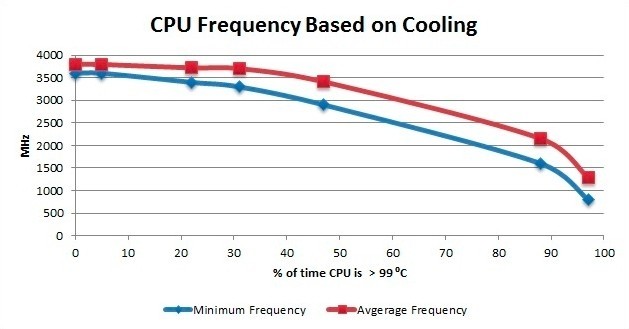
We were very surprised when our testing showed that while the minimum CPU load frequency started to drop as soon as the CPU hit 100 °C, the average CPU frequency didn't drop by more than .1GHz until the CPU was overheating more than 30% of the time. In fact, Intel CPUs are surprisingly good at being able to handle this much heat with such a small reduction in the average frequency.
While this is a great way to understand what is happening from a frequency standpoint, we wanted to know how this affects real-world performance. To do so, we recorded the Linpack performance results to see what the actual performance implications of overheating are:
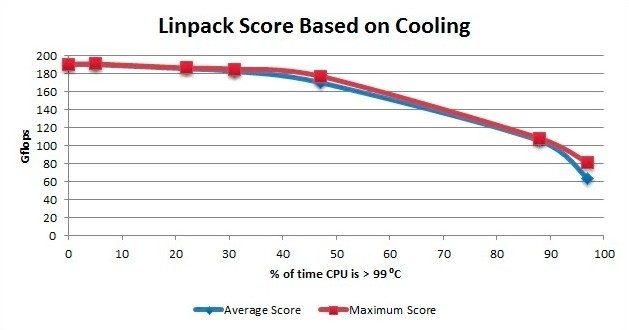
Linpack is one of the most consistent CPU benchmarks we have ever seen and the Intel Core i7 4790 should score right at 190 GFlops with the problem size we used for this testing (30000). What is interesting is that the Linpack results from our testing almost exactly follow the average CPU frequency from the previous graph. While it makes complete sense, this pretty much just confirms that from a strictly CPU performance point of view, the performance of a CPU is directly related to it's average frequency.
So what does this all mean? Beyond the fact that Intel CPUs are impressively stable even while technically overheating it means that you can expect full performance from an Intel CPU as long as you keep it below 100 °C. At the same time, even if the CPU occasionally hits 100 °C you shouldn't see more than a minimal drop in performance until it spends a significant amount of time (more than 20% of the time) above 99 °C.
While the information from the previous section is really interesting, it may be hard to translate into a real world situation. To help with this, we performed the exact same Linpack test except that instead of altering the cooling manually we used two different CPU coolers - the stock cooler that came bundled with the Core i7 4790 and the budget-friendly Cooler Master Hyper TX3 which only costs about $20. To make this as real-world as possible, we installed our test hardware (Asus Sabertooth Z97 Mark II, Intel Core i7 4790, 4x Kingston HyperX LoVo DDR3-1600 4GB, NVIDIA GeForce GTX 980) into a Fractal Design Define R4 chassis with the stock fans running at 5V.
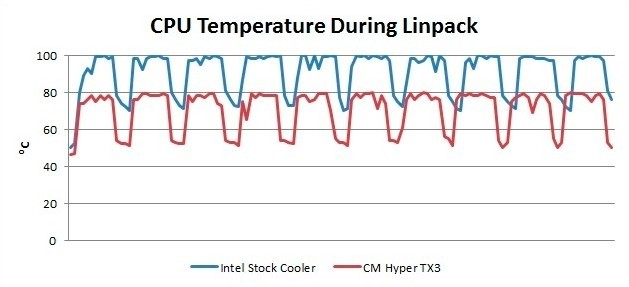
As you can see from the graph above, even a very affordable CPU cooler like the CM Hyper TX3 is able to dramatically lower the CPU temperature under load. While the stock cooler is easily hitting 100 °C during the benchmark run, the CM Hyper TX3 only ever hits a maximum temperature of 80 °C. In terms of how much the CPU was overheating, the stock cooler allowed the CPU to run at > 99 °C about 20% of the time.
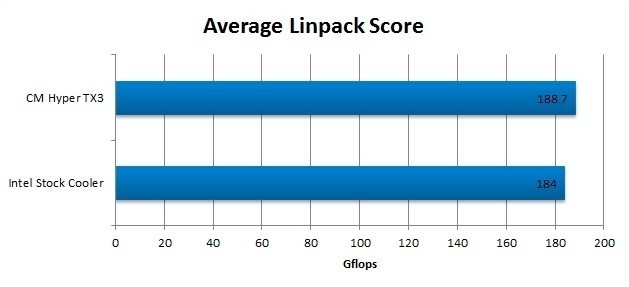
According to our graphs from the previous section, we should expect a measurable, albeit small, drop in performance with the stock cooler. We found that using the stock cooler made the CPU perform about 2.5% slower than it did with the CM Hyper TX3. The neat thing is that this drop in performance almost exactly lines up with our graphs of expected performance from the previous section.
The results of our testing can pretty much be summarized with the following three points:
Frankly, we were a bit surprised at how well modern Intel CPUs dealt with really high temperatures. They manage to run at full speed all the way up to 100 °C, and even then the performance is not greatly affected unless they spend a significant amount of time at that temperature. We certainly don't advocate letting your CPU run at those kinds of temperatures, however. While this article is about performance there are plenty of non-performance based reasons to keep your CPU temperature at a more reasonable level.

Sensitive electronics like CPUs have a finite lifespan and running them at higher temperatures shortens it. So unless you want to have an excuse to upgrade your system often, higher temperatures are counter-productive.
With PC hardware, higher temperatures make both minor and major hardware faults much more likely. These hardware faults can result in anything from reduced performance due to minor errors needing to be corrected to data corruption or bluescreens due to more dramatic errors.
The difficult thing is that just saying "lower temperatures are better" is an overly simplified way to look at CPU temperatures when you consider a PC as a whole. While you canuse giant liquid cooling loops, insanely high flow fans, or even things like liquid nitrogen to keep a CPU extremely well cooled those methods are either expensive, cumbersome, loud, or a combination of all three. In reality it is generally better to let the CPU run a little warm in order to properly balance the cooling against the heat output of the CPU.
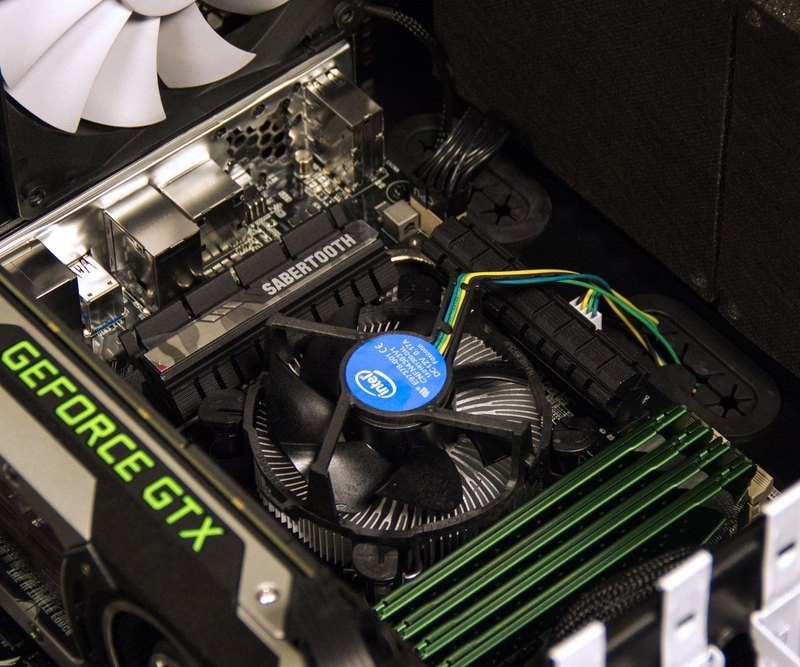
For example, the Corsair Hydro H60 is a great closed-loop CPU cooler used on most of Puget's high wattage CPUs, but it would be overkill for a low-wattage Intel Core i3 CPU. It would certainly keep the CPU well cooled, but it would be much louder, more complex (due to the liquid and pump), and more expensive than what is necessary. Instead, a CM Hyper TX3 or Gelid Tranquillo (if you want to have the system even quieter) would be a better match for that CPU even though the CPU would run slightly hotter under load.
For the average system, a rule of thumb at Puget Systems is that the CPU should run around 80-85 °C when put under full load for an extended period of time. This gives the CPU plenty of thermal headroom, does not greatly impact the CPU's lifespan, and keeps the system rock stable without overdoing it on cooling. Lower temperatures are, of course, better (within reason) but if you want a target to aim for, 80-85 °C is what we generally recommend.
 Amazon Kindle Paperwhite Kids: $139.99 at Amazon
Amazon Kindle Paperwhite Kids: $139.99 at Amazon
 Tesla's new 'dog mode' tells passersby that your pet is OK in the car
Tesla's new 'dog mode' tells passersby that your pet is OK in the car
 New York Governor ‘Amazon Cuomo’ is furious over canceled HQ2
New York Governor ‘Amazon Cuomo’ is furious over canceled HQ2
 'Anthem' players are angry about long load times but there's a fix
'Anthem' players are angry about long load times but there's a fix
 Golden State Warriors vs. Los Angeles Lakers 2025 livestream: Watch NBA online
Golden State Warriors vs. Los Angeles Lakers 2025 livestream: Watch NBA online
 Netflix's 'Umbrella Academy' puts heroes in bonkers family dramedy
Netflix's 'Umbrella Academy' puts heroes in bonkers family dramedy
 NBA dunk contest winner, rookie Hamidou Diallo, leaps over Shaq
NBA dunk contest winner, rookie Hamidou Diallo, leaps over Shaq
 Watch of the week: 'RoboCop' was a gem way ahead of its time
Watch of the week: 'RoboCop' was a gem way ahead of its time
 Best Samsung Galaxy Watch Ultra deal: Save $200 at Best Buy
Best Samsung Galaxy Watch Ultra deal: Save $200 at Best Buy
 I thought I was good at 'Tetris' until I played 'Tetris 99'
I thought I was good at 'Tetris' until I played 'Tetris 99'
 Apple is advertising on Elon Musk's X again
Apple is advertising on Elon Musk's X again
 Assman finds a way around vanity plate rejection with a massive decal
Assman finds a way around vanity plate rejection with a massive decal
 Pirated iOS apps are being distributed through Apple's enterprise developer program
Pirated iOS apps are being distributed through Apple's enterprise developer program
 The Trump allegations have sparked a grim new Twitter trend
The Trump allegations have sparked a grim new Twitter trend
 Best external hard drive deal:WD 5TB Elements for $114.99
Best external hard drive deal:WD 5TB Elements for $114.99
 These cannot be the names of actual places in the UK, and yet they are
These cannot be the names of actual places in the UK, and yet they are
 Janet Jackson confirms that she's pregnant and will continue her ultra
Janet Jackson confirms that she's pregnant and will continue her ultra
 To prove he's not a demon, President Obama sniffed himself
To prove he's not a demon, President Obama sniffed himself
 Best iPad deal: Save $70 on 10th Gen Apple iPad
Best iPad deal: Save $70 on 10th Gen Apple iPad
 Netflix's 'Umbrella Academy' puts heroes in bonkers family dramedy
Netflix's 'Umbrella Academy' puts heroes in bonkers family dramedy
Watch this kangaroo bounce through a deserted Australian city'Brooklyn Nine'The Night Agent' literally doesn't sleep. Someone allow him a nap.How to have a socially distanced 420Twitter's verified blue tick badges are now identical to paid onesThis is what a sociallyApple's Weather app not working. What we know.A new French bill could send influencers to jail'Rye Lane' review: Lovable losers romTwitter's newlyWordle today: Here's the answer, hints for March 31Apple's AirPods case might one day get a touch displayWWE to merge with UFC parent company Endeavor. What we know.New Google Flights feature guarantees the lowest price, pays you back if it’s wrong'Quordle' today: See each 'Quordle' answer and hints for April 1People are dunking on an old Steve Mnuchin video about the $1,200 stimulus checksNew Google Flights feature guarantees the lowest price, pays you back if it’s wrongDo not inject yourself with bleach to cure coronavirus, holy crapTwitter's verified blue tick badges are now identical to paid onesStop comparing coronavirus to other deadly viruses 'The Matrix Awakens' demo is now downloadable. Here's the full video. Trump faces defamation charge from Stormy Daniels over "con job" tweet The 'build the perfect man' meme is a troll Is Shiv pregnant with Tom's baby at the end of 'Succession' Season 3? What that bonkers 'Succession' finale means for the Roys in Season 4 Time names Elon Musk Person of the Year for 2021 Kim Kardashian interviews Kylie Jenner about becoming a mom How different self A Coinbase 'display issue' glitch showed incorrect customer wallet balances A comprehensive timeline of Kanye’s latest nonsense behavior Parker Solar Probe mission: NASA spacecraft dives into sun's corona Elon Musk to test Doge purchases for Tesla merch Here are the best gadgets of 2021 'Sex and the City' character dies on Peloton bike, and the company isn't having it 'Hook' celebrates its 30th anniversary with a snazzy soundtrack record from Mondo Aaron Sorkin's 'Being the Ricardos' is fine enough, but never dazzles: Review Amazon's phone ban criticized in wake of Illinois warehouse collapse 'Spider 'Among Us' is coming to VR: Watch the eerie teaser trailer Uhh, people keep searching for 'Cardi B' on Pornhub
1.1229s , 10242.65625 kb
Copyright © 2025 Powered by 【erotice temporary tattoos】,Feast Information Network